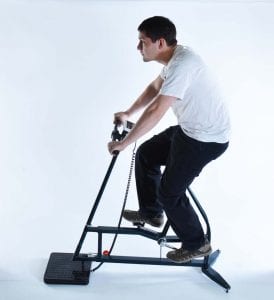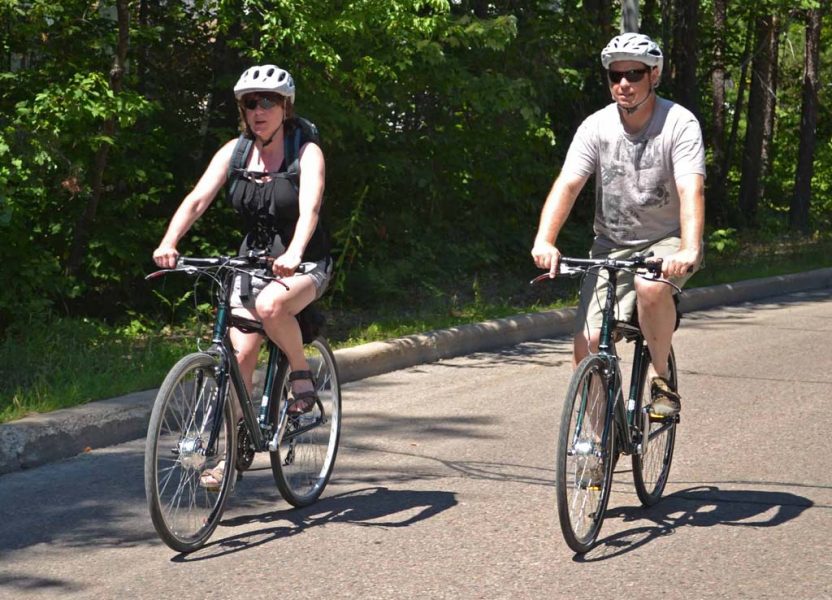Our Frame Geometries
Our “hybrid” model bikes have characteristics of a road bike (light weight, 700c large diameter wheels for low rolling resistance) and characteristics of a light-duty mountain bike (somewhat wider tires, non-drop handlebars, more upright riding position). A hybrid design allows riders to sit in an upright position that gives them good visibility, good control, and a posture that reduces strain on their neck and back. European cyclists have enjoyed these advantages for decades. A trip to Holland, the bike capital of the world, with 40% of all traffic movement by bicycle, should convince any skeptic of the merits of this riding position. Most Dutch riders are on upright style bicycles (except on Sundays, when the racing enthusiasts are out!). It is our opinion that the North American bicycle industry has been and still is, too fixated on sport bikes, both racing and off-road. To pretend these sports products are best for everyday use is a bit of a disservice to the people who buy them.
Bike Comfort
Following is a discussion of bike sizing and fit for “comfortable” riding in an upright posture. Through experiment and testing with dozens of bike club “touring” riders, we have found that certain key measurements of the way they have set up their bikes correlate to their body dimensions of inseam and arm length. Based on these measurements, when we set up our bikes to our customer’s body dimensions they are usually quite satisfied with the feel. “Comfort” is of course a hard feeling to define & quantify.
In fitting a bicycle to a particular person there are of course many considerations, and for competitive cyclists there are many different “systems” for doing it….but it is definitely not an exact science. Moreover, most of the “fit” systems in common use at bike shops have their roots in competitive cycling, where positioning the rider for maximized power output is of paramount importance, and comfort is secondary. However, when comfort is given priority over the ergonomics of power transfer, and when we are dealing with an e-bike (the rider is spared from the need for heavy exertion), precise positioning of the rider on the bike is much less critical. An upright riding position simplifies the ergonomics enormously. We have found though, that there are some key factors for comfort.
A basic fact seems to be that there is little available data on fitting a bicycle for comfortable riding in an upright position. This prompted us to develop our own data. We have been adding to our database for several years now. It relates key body dimensions (inseam, shoulder height and arm length) of seasoned recreational riders, to the saddle height, handlebar height and handlebar reach of their bikes. Our focus has been on recreational cyclists and commuters on “hybrid” type bikes having straight or offset handlebars (not drops), and is admittedly of little relevance to racers. A key assumption of course, is that the riders in our database have, over the years, managed to size & adjust their bicycles to an optimum level of comfort for their body dimensions. We are satisfied that this is true.
Our first observation (not at all original!) is that saddle height correlates well with inseam length. Our second finding (also not new) is that handlebar fore-and aft position (horizontal distance from the top of the seat post to the cyclist’s hands) correlates well with rider arm length. We found that handlebar height at the grips, varied quite a bit amongst our riders, but in general shorter riders tended to have the handlebars at or above saddle level. Taller riders generally had their handlebars lower than the saddle. We theorized that this might be more a factor of the technical difficulty of achieving a higher handlebar position for very tall riders.
To further study rider comfort in a controlled setting, we used an adjustable simulator bike (see Figure 1). It can be adjusted to simulate an extended range of frame sizes from 45 to 62 cm. A digital scale measures weight on the front wheel. Change in a rider’s weight distribution can be measured as seat height, seat position, handlebar height and handlebar reach are altered. The simulator has functional pedals but they are intentionally freewheeling (so comfort can be assessed independently of rider pedaling force).
We had our test cyclists “ride” the simulator and adjust it for perceived “comfort”. As in the field tests, seat height and handlebar reach correlated well with inseam and arm length. Once seat height and handlebar reach were set at what was judged to be optimum values for each particular rider, we then altered handlebar height (relative to seat height) in increments. Without exception, all “riders”, regardless of their height, felt less arm and upper body load with a handlebar position equal to or above saddle height. As the handlebar was brought from a position well below saddle height up to saddle height, the change in the percentage of weight on the front wheel dropped at an increasing rate. Raising the handlebar above saddle height had a diminishing effect on weight distribution. We concluded that for upper body comfort, getting the grip height up to saddle height is important. We have achieved this on our bikes by using forks with uncut 300 mm long steerers. For tall riders we use riser-type handlebars, a steeply rising stem, or a stem riser adapter. Reducing the “reach” (horizontal distance from seat post to handlebars) by using a shorter stem also improves comfort.
Modern bikes are generally offered in a range of proportionally sized frames (as the size increases, they are not only taller but also longer i.e., longer seat tubes accompany longer top tubes). As the frame size changes, the wheelbase, rider weight distribution and hence steering characteristics change slightly. For non-racers these changes are barely noticeable, and certainly not of major importance. What is important is the relative positioning of the rider’s seat, feet, hands and center of gravity, i.e., his contact points with the bicycle relative to his balance point. For upright riding, especially on a power-assisted bike, a multitude of incremental frame sizes is not warranted. Our hybrid model e-bikes are available in two sizes, which together can typically accommodate a range of riders from 5’ to about 6’ 2” in height. Very tall riders outside this range are best accommodated by our 21” “Responder” bike, which is available in a wide range of frame sizes.
Figure 1: Simulator bike



